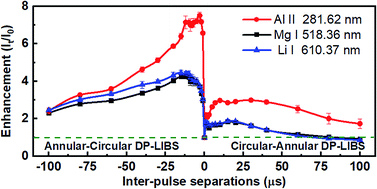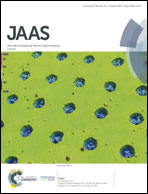Enhanced laser-induced breakdown spectroscopy using the combination of circular and annular laser pulses
Abstract
We have investigated a new double pulse laser-induced breakdown spectroscopy (DP-LIBS) method using the combination of circular and annular nanosecond laser pulses. The aim of this study is to enhance the LIBS sensitivity through a better coupling of laser energy to the target and ablated matter, leading to more efficient production of trace analyte atoms in an excited state. Using the annular laser pulse and circular pulse delayed by 10 μs, without superposition of the laser-ablation zones, we achieved nearly 4 times signal enhancement and nearly 3 times LOD improvement of the trace elements (Li and Mg) in aluminum alloy as compared to the case of simultaneous irradiation of annular and circular pulses. Time resolved studies show that the annular–circular laser ablation can lead to a hot and dense plasma after the second pulse irradiation, and therefore stronger spectral emission from the plasma was obtained. This could help us to develop a more effective in situ and minimally destructive LIBS system for the trace impurity deposition on the first wall in the fusion device.



 Please wait while we load your content...
Please wait while we load your content...